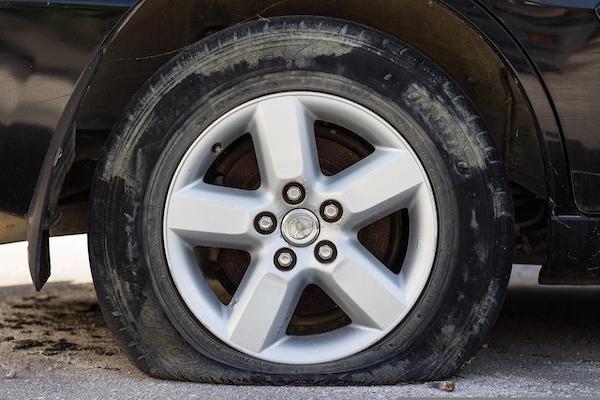What to Know About Tire Blowouts

Below, we detail everything you should know about tire blowouts.
Warning Signs of Tire Failure
Your tires play a critical and, unfortunately, often overlooked role in the safety of your vehicle and, as such, your safety when you’re driving. Your tires are the only part of your car that’s physically touching the ground. That makes them a key factor in handling and braking, as well as overall safety.There are things you can do to keep your tires in good working condition and spot problems early on before they get worse.
Visually inspect your tires regularly. You want to take just a minute to walk around your car and see if you spot warning signs.
Problematic red flags include:
- Cuts or cracks in your tire sidewall.
- Treadwear that’s uneven—this can stem from suspension problems, damaged tires, improper inflation, or wheels that are out of alignment
- Tread that’s excessively worn—most tires have indicator bars along with the tread, and these show you the minimum allowable tread depth. If the tread wears down to those bars, you might need new tires.
- You can also use a quarter and penny if your tires don’t have treadwear indicators. Put the quarter into a tire groove, keeping the head toward the tire. If you can see the top of George Washington’s head, you need to take your car into the shop and consider new tires. If you can see Abraham Lincoln’s head using the penny, you need to replace your tires immediately.
- Tires with bulging or blisters need to be replaced—these are signs of weak spots that could lead to failure.
- If your car seems like it’s vibrating excessively, a wheel could be out of balance, misaligned, or bent. It could also be a sign of internal tire damage or a problem with the suspension.
• If you’ve ever been on the roadways and you’ve seen layers of tires coming from trucks, or you’ve seen scraps of tires along the road, it can mean the vehicle leaving them behind was shedding its tires. Shedding usually occurs because tires aren’t inflated properly, and then there are temperature changes occurring at different rates. This can potentially lead to a blowout if the tire gets too thin, losing excessive tread. This is a sign that you, of course, would be looking for on other vehicles and large trucks on the road more so than on your own.
Underinflation
According to research, underinflation may be a major problem that people don’t even realize. Tires lose air through the rubber at the point where it connects the wheel and the valve. The air loss can be so slow that people don’t notice it’s going on. When there are seasonal temperature changes, it can also make tire pressure drop.The sidewall flexes more when the tires are at a lower pressure. The underinflation at that point is compromising driving control from the tire. Even a very small relative pressure loss affects how a car handles, so it’s harder for you to control. It can also make your ride softer.
Another consequence of underinflated tires is that they make a car’s fuel economy worse, meaning you’ll pay more for gas.
When your sidewall flexes too much, heat can build up, shortening the lifespan of your tire and raising the likelihood of separation or blowout.
When it comes to inflation maintenance, remember the following:
- You can’t judge pressure just by looking at your tire. Modern tires are constructed in a way where they bulge slightly, which makes them look underinflated, regardless of whether or not they are. If you’re parked on a soft surface, that can be an exaggerated effect.
- Use a tire gauge to check the pressure at least once a month.
- Set your tires to what the car maker recommends. Don’t go by what you see listed as the maximum inflation pressure on your tire. If your car has a space-saver spare, you should also check that it’s properly inflated.
- When you’re measuring pressure, do so when the tires are cold, before you drive more than a mile or so.
What If Your Tires Blow Out?
Tire-related accidents lead to thousands of deaths every year, according to the National Highway Traffic Safety Administration.Accidents from blowouts are among the deadliest because of the potential for collision and also the risk the blowout could cause other cars or vehicles to spin into different lanes of traffic or go off the road.
When your tire blows out, it explodes, leaving a hole. Then, your tire quickly loses pressure and deflates.
If you’re experiencing a blowout, your steering wheel may start to shake, or it can get harder to steer, depending on how fast you were going when your tire blew. If you do experience a blowout, let the car naturally decelerate and steer it to a safe place. Try to move your car out of traffic and off the road.
Sometimes we want to naturally react if there’s a situation where a car slows down or gets hard to drive, and that can lead some people to hit the brakes or try to turn off the road fast to get out of traffic. That can cause the car to spin.
If the car spins, you’re at a higher risk of getting injured or hitting something. You can also cross lanes, causing you to hit other cars, people, or property.
Finally, if you see someone else’s tire blow out, debris can scatter across the roadway. Other cars might sharply steer to try and avoid it, and the truck driver could overcorrect, panic and slam the breaks. Then, the truck will jackknife. In these situations, stay as far away as possible, and don’t panic.
Do You Need An Attorney?
If so, post a short summary of your legal needs to our site and let attorneys submit applications to fulfill those needs. No time wasted, no hassle, no confusion, no cost.

